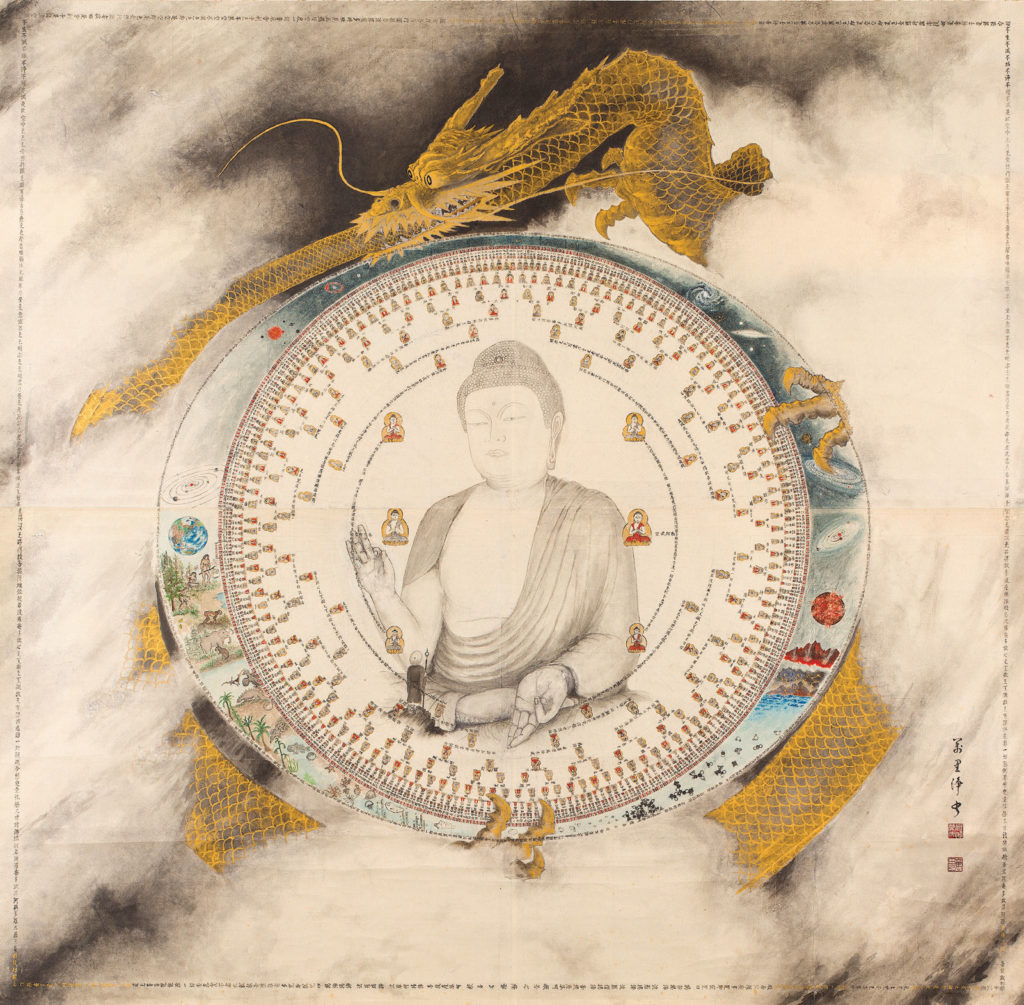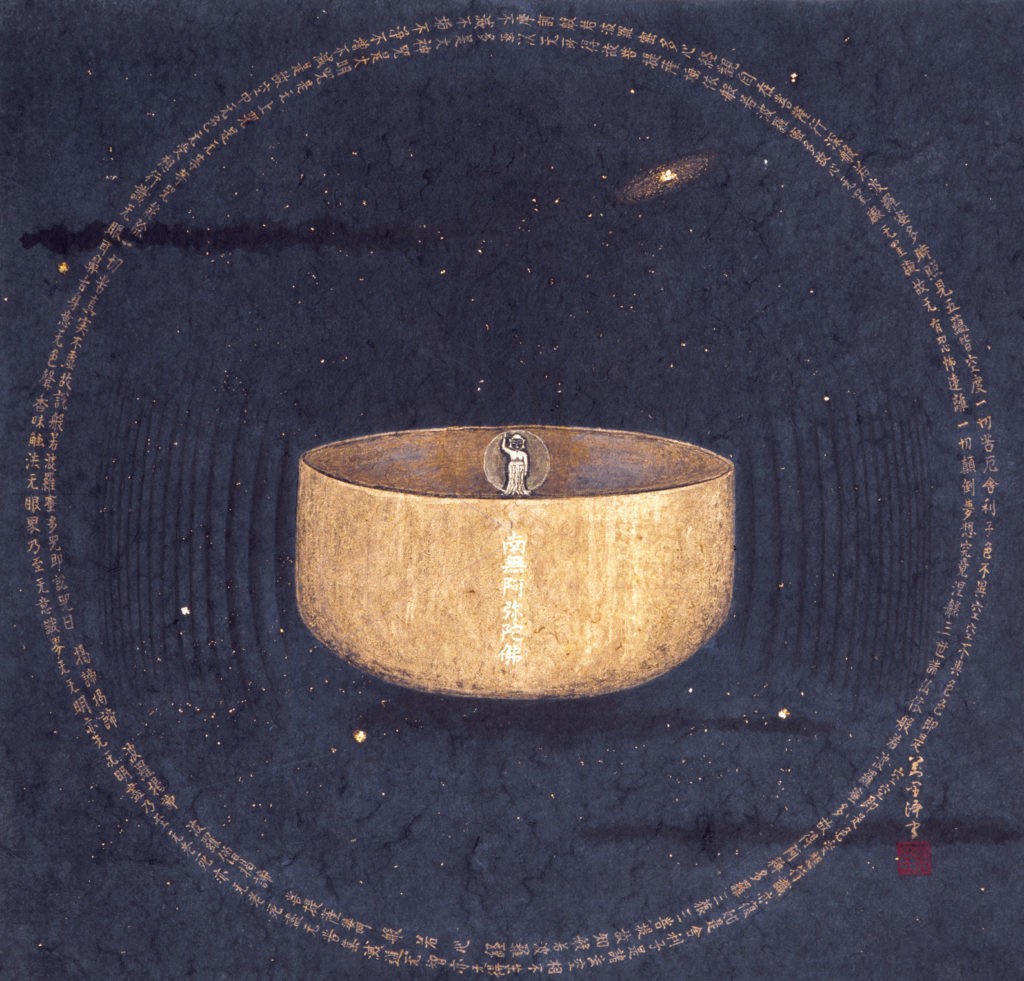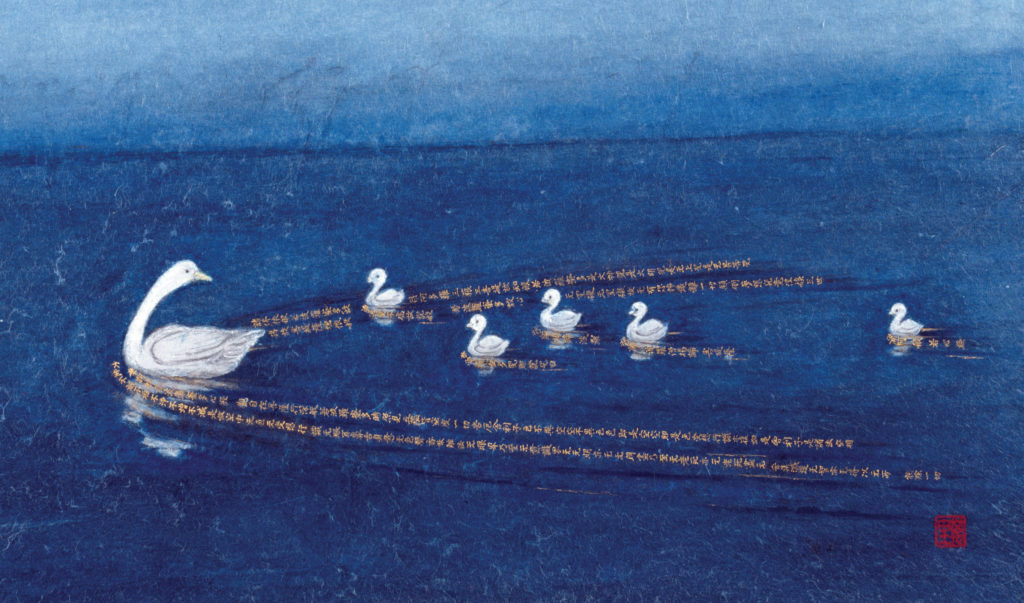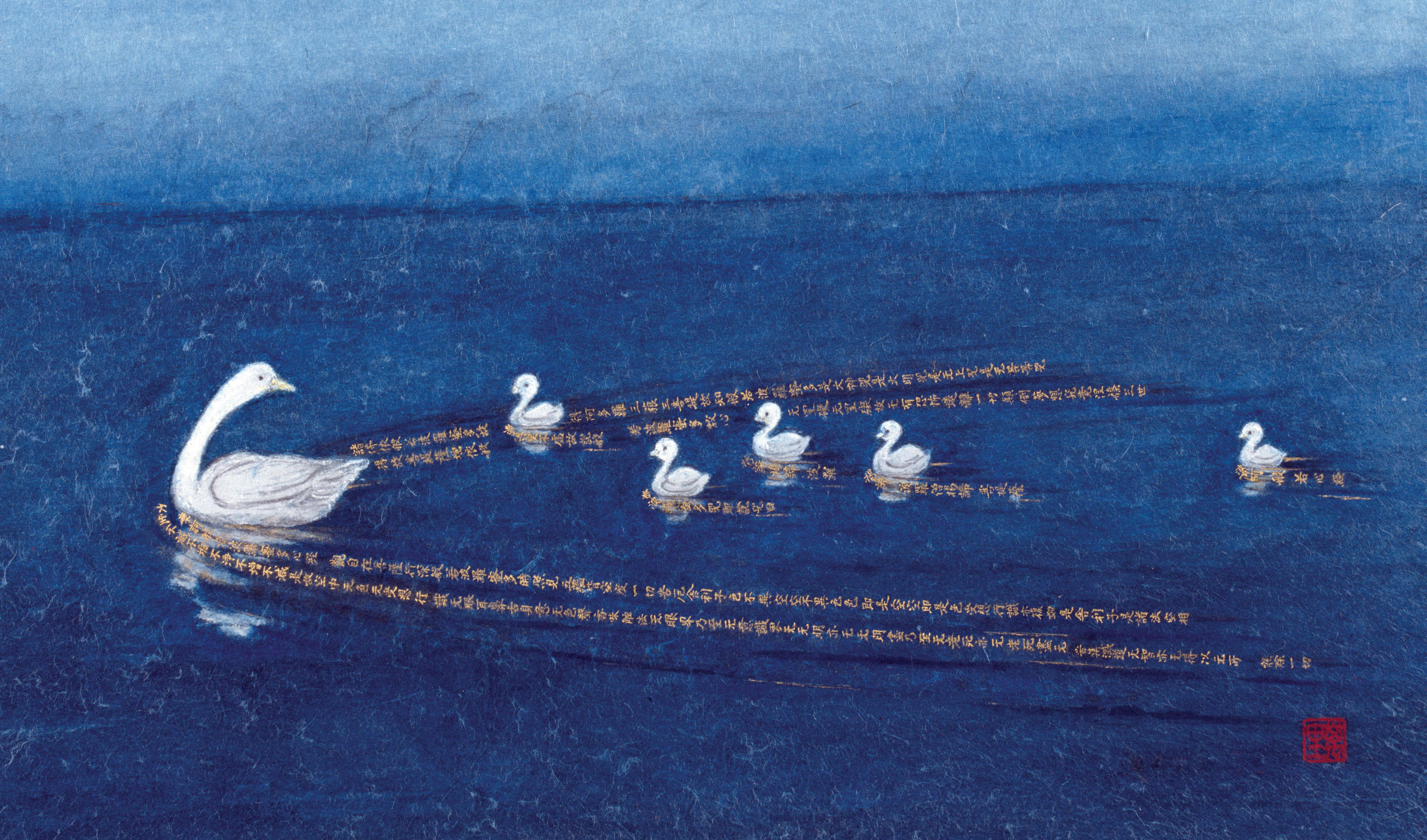Healing visions of the Heart Sutra

The extraordinary paintings on the next several pages were begun at age seventy by Iwasaki Tsuneo (1917-2002), a retired Japanese research biologist. Iwasaki, who fought for his country during WWII, was raised as a Buddhist and pursued Buddhist studies throughout his life, finally choosing the Heart Sutra as his principal focus.
The Heart Sutra, author unknown, dates to the seventh century A.D. and is considered a core text of Mahāyāna Buddhism. The sutra comments on the fundamental emptiness of all phenomenon. Its most famous formulation is “Form is emptiness; emptiness is form. Form is not different from emptiness; emptiness is not different from form.”
In retirement, Iwasaki spent years studying calligraphy, and at age sixty-three took up the traditional practice of scripture-copying, reproducing the Heart Sutra in calligraphy nearly two thousand times. At age seventy, he applied his now expert calligraphic skills to the great array of paintings that are sampled in these pages and that unite with great insight and originality both spiritual and scientific understanding.
The meticulous attention and passionate devotion invested by Iwasaki in these paintings is evident in every brush stroke. For his ink, he did not add simple tap water to his ink stick; rather, each year, on the seventh day of the seventh month, he collected dewdrops from lotus flowers, using this liquid for his ink. His brushes ranged from ten hairs wide to three hairs wide. He painted on washi (traditional Japanese fibrous paper) through a magnifying glass; the works range in size up to the seventeen-foot-wide Big Bang: E=mc2. Each work depicts the Heart Sutra within its borders.
Iwasaki’s work—here presented with commentary by scholar Paula Arai—has gained in appreciation and renown since his death. The Dalai Lama has blessed it. May we all benefit from it.
—The Editors
RAINBOW OF FORGIVENESS
What can I do if I forgive?
It was not until after retiring from research on viruses that Iwasaki saw he had divided reality up by looking at it only through his scientific perspective. He felt mortified that he had not treated with respect the animals that supported his research, only seeing them as things to measure. He looked mournful as he explained how this painting was his expression of repentance from his estranged way of relating to his animal research subjects. He wanted to focus on reality in its wholeness. Contemplating nonduality—that ultimately there is no subject and object—released guilt and shame that constricted him. As his heart became unbound, penetrating gratitude flowed to the animals that had helped him, especially silkworms. Gratitude helped him see reality in its wholeness, and forgiveness helped him return to wholeness.
Squarely facing this reality, he paints himself in hell to assist the animals out of the realm of suffering to which he had conscripted them. With an exultant awareness that research animals are integral to the greater whole, he entrusts the beauty of a rainbow to convey his gratitude and to celebrate opening his heart to our wholeness. Effulgent with Heart Sutra wisdom on the interrelated nature of existence, Iwasaki’s Rainbow of Forgiveness accentuates forgiveness as an act of compassion to the self, which activates compassion for others.
RINGING BELL

How do I make my heart ring with compassion?
Summoning the bodhisattva of compassion, Kannon—whose name in Japanese means “see sound”—Iwasaki shows us sound waves resounding into the cosmos, echoing the spiraling galaxy. Signified by ensō circles, the waves ripple with the teachings of the Heart Sutra. The baby Buddha brims with the timbre of growth. Carved in gold, “Namu Amida Butsu” heralds the vow of compassion embedded in each toning of the bell.
After his mother passed away, Iwasaki continued her morning ritual of lighting a candle, offering incense, and ringing the home altar bell before chanting. Tolling a bell in your home bathes the inhabitants in currents of calming compassion and suffuses the home with the sound of wisdom. Listening to a bell with our heart creates a space safe for dissolving debris, unclogging lines of connection, and dispelling clouds that obscure our vision. Subtle and nimble, the sound waves infuse each sliver and crack in the heart with the healing that comes from being made whole with
the fullness of the present moment. Here, world peace does not sound naïve. The voice of justice does not ring hollow. Ritually intoning a bell enables us to hear the complex harmonies of the cosmos as one moves through one’s day attuned to the Heart Sutra.
COMPASSION RIPPLES

How am I held in love?
Cradled in blue, a brood of ducklings swims in the protective wake of Heart Sutra ripples that their mother radiates as she looks lovingly aft. Embracing her young and vulnerable charges, she quells their fears and tends to their growth.
In Compassion Ripples, Iwasaki shows us what a compassionate relationship between parent and child looks like. Iwasaki ached that not everyone knows such compassion. He penned his pain, “Saddened to live in a time when people are lost and in an age where parents kill children and children kill parents.” This painting is a prayer for compassion. Seeds of compassion are watered with each intimate connection. Compassion generates inspiring and empowering energy. Parents embody compassion when they nurture compassion in their children. Suffering ceases when we experience the universe as a vast interdependent web where we are all parents and we are all children. ◆
From Painting Enlightenment: Healing Visions of the Heart Sutra by Paula Arai © 2019 by Paula K. R. Arai, Ph.D. Reprinted in arrangement with Shambhala Publications, Inc. Boulder, CO. www.shambhala.com
PAULA ARAI is the Urmila Gopal Singhal Professor in the Religions of India at Louisiana State University. She is the author of BRINGING ZEN HOME and WOMEN LIVING ZEN.
IWASAKI TSUNEO (1917-2002) was a Japanese biologist and artist who created a strikingly original body of modern Buddhist artwork, ranging from classical Buddhist iconography to majestic views of our universe as revealed by science, created with the use miniature calligraphies of the Heart Sutra.
From Parabola Volume 44, No. 3, “Mercy & Forgiveness,” Fall 2019. This issue is available to purchase here. If you have enjoyed this piece, consider subscribing. Four times a year Parabola has explored the deepest questions of human existence. Without your support, we would cease to exist. Please consider helping us by making a donation.

